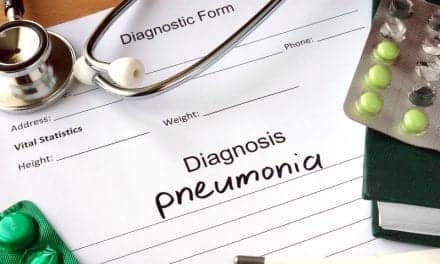Obstructive sleep apnea (OSA) patients who also have obesity hypoventilation syndrome may have nocturnal oxygen desaturation despite continuous positive airway pressure (CPAP), according to a report in the June issue of Chest. Few studies have investigated the "short-term effect of CPAP on sleep-disordered breathing, sleep architecture, arousal indexes, and nocturnal desaturation in clinically stable patients with OSA plus obesity hypoventilation syndrome," the authors write. Dr. Dev Banerjee from the Birmingham Heartlands Hospital in the UK and colleagues compared the degree of sleep-disordered breathing and oxygenation abnormalities in 23 very obese patients with OSA and 23 with OSA plus obesity hypoventilation syndrome, and studied the initial effects of CPAP in these patients. Sleep apnea severity and arousal indexes did not differ significantly between the two groups, the authors report, although the total apnea-hypopnea index and arousal index tended to be greater in the OSA-plus-obesity hypoventilation syndrome group. Oxygen desaturation occupied a greater percentage of total sleep time in the OSA-plus-obesity hypoventilation syndrome group, the results indicate. CPAP improved the total amount of REM sleep, arousal indexes, apnea/hypopnea severity, minimum oxygen saturation, and percentage of total sleep time with oxygen desaturation, the researchers note. Even with CPAP, however, the OSA-plus-obesity hypoventilation syndrome group continued to have statistically worse percentages of total sleep time with oxygen saturation below 80% and 90%, lower minimum oxygen saturation, and lower oxygen saturation while awake, the report indicates. Ten patients in the OSA-plus-obesity hypoventilation syndrome group (43%) continued to desaturate despite adequate treatment of the upper airway obstruction by CPAP, compared with two patients in the OSA-only group (9%), the investigators say. "Residual desaturation in many OSA-plus-obesity hypoventilation syndrome subjects during initial CPAP probably reflects continued hypoventilation despite the reversal of apneic events," the authors suggest. "Further controlled longitudinal studies comparing bilevel noninvasive ventilatory support against CPAP in obese subjects with obesity hypoventilation syndrome plus OSA are warranted," they conclude. "Banerjee and colleagues have provided convincing evidence that CPAP can be successfully titrated in the majority of patients with stable obesity hypoventilation syndrome, and their findings will give impetus for well-designed randomized controlled trials comparing long-term outcomes with different treatment modalities in patients with obesity hypoventilation syndrome," writes Dr. Babak Mokhlesi from The University of Chicago Pritzker School of Medicine, Chicago in a related editorial. "In the meantime," Dr. Mokhlesi says, "bilevel PAP should be considered the treatment of choice in patients with obesity hypoventilation syndrome if nocturnal hypoxemia is persistent despite an adequate CPAP titration."









